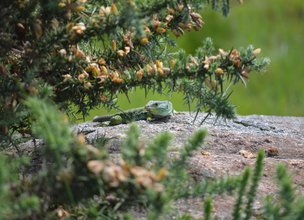A plateau full of life at the top of the Serra d'Arga.
The granitic mountainous is the most significant part of this SCZ, where plateaus with several depressions appear, poorly drained. Here, habitats of the hygroturfous type occur, associated with permanent water courses and temporary flooding areas.
As Serra d’Arga is the first major interior obstacle to humid winds originating in the Atlantic, the climate in this region is not very rough, typically temperate, although in the higher areas snowfall and frost may occur.
This area has a wide variety of habitats, which are home to a large number and diversity of floristic and fauna species. However, the proliferation of invasive exotic species puts at risk the integrity of this ecosystem and its ecological importance, and it is necessary to implement concrete urgent measures for its conservation.
In this place, inserted in the Serra d’Arga SCZ, the habitats contained in the Habitats Directive occur:
7140 - Transition and undulating peat bogs
7150 - Rhynchosporion peat substrate depressions
4020* - Wet temperate heaths of Erica ciliaris and Erica tetralix - priority habitat.
The granitic mountainous is the most significant part of this SCZ, where plateaus with several depressions appear, poorly drained. Here, habitats of the hygroturfous type occur, associated with permanent water courses and temporary flooding areas.
As Serra d’Arga is the first major interior obstacle to humid winds originating in the Atlantic, the climate in this region is not very rough, typically temperate, although in the higher areas snowfall and frost may occur.
This area has a wide variety of habitats, which are home to a large number and diversity of floristic and fauna species. However, the proliferation of invasive exotic species puts at risk the integrity of this ecosystem and its ecological importance, and it is necessary to implement concrete urgent measures for its conservation.
In this place, inserted in the Serra d’Arga SCZ, the habitats contained in the Habitats Directive occur:
7140 - Transition and undulating peat bogs
7150 - Rhynchosporion peat substrate depressions
4020* - Wet temperate heaths of Erica ciliaris and Erica tetralix - priority habitat.
Location
Chã de Arga corresponds to a plateau at the top of Serra d'Arga, in the parish of Montaria.
Coordinates
Lat: 41.800222
Long: -8.696444
Hello little one!
I'm Piquinhos and I can help you learn more about the Geopark!
Biodiversity
Biodiversity
The floristic variety in the higher altitudes is not very high. However, rare habitat types or interesting features occur here, such as peat bogs and hygrophilous scrub, resulting from areas with high humidity and acidic substrates.
Peat bogs are habitats that develop due to the growth of peat moss (Sphagnum spp.), a moss that changes the conditions of the environment, acidifying the substrate. On the sphagnum mantle, other plants adapted to this habitat grow, such as Erica tetralix shrubs.
Associated with peat bogs, insectivorous plants also appear, such as Pinguicula lusitanica and round-leaved sundew (Drosera rotundifolia), which capture and digest insects to compensate for soil deficiency in some nutrients, such as phosphate and potassium. There is also the endemic plant Carex durieui, whose population in Serra d'Arga is the largest in Portugal, and the "raiz-divina-de-cheiro" (Armeria humilis subsp. odorata), which is a very restricted distribution endemism .
In the plateau, there are still areas of hygrophilous "arranha-lobos" (Genista berberidea) and "cervunais", which consist of mountain meadows where Arnica (Arnica montana subsp. Atlantica) occurs.
Regarding fauna, although there is not a very high specific wealth in this area, there are several species of conservation interest. Thus, the presence of day and night prey is recorded, such as the peregrine falcon (Falco peregrinus), the Eurasian eagle-owl (Bubo bubo), the short-toed snake eagle (Circaetus gallicus) and the montagu's harrier (Circus pygargus) as well as some smaller birds. Some species of reptiles and amphibians, such as the ocellated lizard (Timon lepidus) and the natterjack toad (Epidalea calamita), are also present.
In this area there is also the gray wolf (Canis lupus), a predator of another large mammal present in the area, although of domestic origin - the "garrano". The remains of the garrano's corpses served as food for necrophagous birds, such as the griffon vulture (Gyps fulvus).
Discover some of the species that can be found in this location, under the "Multimedia" tab.
Child Mode
Discover the geopark in a simpler format, aimed at the little ones.
Clique ENTER para pesquisar ou ESC para sair
